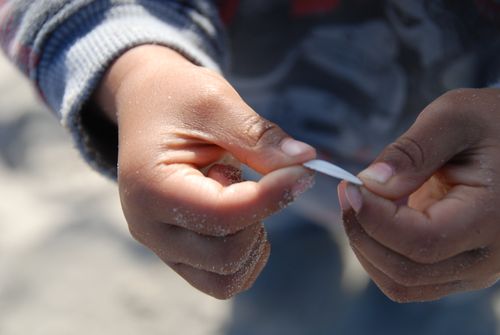Last Sunday, in an effort to break the post-nap play away from crashing, roaring, banging, jumping, I set up the easel in the living room with baby jars full of tempera. And to my surprise there was a serious flurry of painting that ensued. Usually our painting sessions are laughably short. But this time, before I could look up, a page would be filled with color and on the floor and another would be halfway done. It was funny. It was almost like little boy aggression therapy.
Put coconut oil, brown sugar, maple syrup, vanilla and salt into a large saucepan over low heat.
I'll begin my first post here with a trip some said I was brave to take: camping alone with my two sons. Mazi headed to DC to celebrate the impending birth of one of her dear friends, so I headed to Leo Carillo with the boys, and an old friend with his son.
When we arrived at the campsite I was excited and focused. I had rehearsed many times in my head all the things I had to do before nightfall. To me this was survival. But the kids had different ideas. They wanted to explore the campsite, meet people, chase each other around with sticks. I tried to be firm and authoritative, keep them safe. I wanted them in my eyesight at all times, but I couldn't pitch the tent, cook the food, tend to their needs, while watching them like a hawk. After much shouting and angst, I realized that I needed to be more flexible. They were having a blast, and I was the only obstacle. As I sat there struggling, the tent flapping in the wind, I remembered that we were there to forget about the rules and routines. I quickly faded to the background, did my survival thing, and let the kids run and explore every bit of nature they could find.
We ended up having a wonderful time. Survival was a lot of work indeed, but the kids enjoyed every minute, which in turn made me forget about the work. For Mateo, it was a welcomed opportunity to discover new things and test himself in new ways. For Nico, it was learning to hang with the older kids and find his own way in nature. And for me, it was a great lesson in letting go.

Each afternoon that I walk into Mateo's preschool room to pick him up, I am usually amazed at the fruits of the children's creative efforts that day. Someone will have built a massive and elaborate fortress out of wood blocks with glass pebbles, snakes and wire, someone will have drawn a picture of sage flowers that looks more intricate than what most adults could produce, or there will be a ferris wheel or roller coaster made entirely of wood. These are three and four-year-olds I'm talking about.
One day I walked in and saw this drawing of Mateo's face on the wall, and I was totally taken aback. Up until very, very recently, Mateo's drawings were mostly furious, multi-colored scribbles. But suddenly there was a face, with eyes, and ears, and hair–his hair! It actually looked a lot like him. His teacher Michele explained how they did it: using an overhead projector, they put a photo of Mateo's face on the wall and he traced over it then painted it. I couldn't wait to take it home, but as it goes, I had to be a little patient. But now it's here, and I love looking at it. I do think it gives a glimpse into how Mateo sees himself and his world–all loose and freeform. And I especially love that he thinks he's got shiny gold sparkles in his hair.
There has been some serious bread making going on here the past couple of months, which is a new thing. Over the long span of our relationship, I've heard Matt talk often about his grandmother's bread. How during his summers in Cape Cod, he would watch Morm make bread from scratch everyday: the stacks of saved butter wrappers for the pans; her long fingers kneading, slapping, cutting into the dough; and at the end, the lone bowl covered with a towel as the dough rose in the sun. Legend has it that she would cut the bread so thin you could see through it. But as there were often a dozen or so people to feed at a time, Matt says it makes sense. Now.
Our bread making hasn't quite reached the same level of quotidian proportions yet; we are weekend bakers for sure. We've been mostly making this recipe from Smitten Kitchen, but we had some friends for dinner last night and made these parmesan rolls that were pretty terrific. All we need now is to somehow curb our consumption, because before this bread making began, the only bread we ever kept in the house was for the kids' pb&j's. Uh-oh.
Light Wheat Bread
The Bread Baker’s Apprentice
Makes one two-pound loaf
2 1/2 cups (11.25 oz) unbleached high-gluten or bread flour
1 1/2 cups (6.75 oz.) whole-wheat flour
1 1/2 tablespoons (.75 oz.) granulated sugar or honey
1 1/2 teaspoons (.38 oz.) salt
3 tablespoons (1 oz.) powdered milk*
1 1/2 teaspoons (.17 oz.) instant yeast
2 tablespoons (1 oz.) shortening or unsalted butter, at room temperature
1 1/4 cups (10 oz.) water, at room temperature
Stir together the high-gluten flour, whole-wheat flour, sugar (if using), salt, powdered milk, and yeast in a 4-quart mixing bowl (or in the bowl of an electric mixer). Add the shortening, honey (if using), and water. Stir (or mix on low speed with the paddle attachment) until the ingredients form a ball. If there is still flour in the bottom of the bowl, dribble in additional water. The dough should feel soft and supple. It is better for it to be a little too soft that to be too stiff and tough.
Sprinkle high-gluten or whole-wheat flour on the counter, and transfer the dough to the counter, and begin kneading (or mix on medium speed with the dough hook). Add more flour if needed to make a firm, supple dough that is slightly tacky but not sticky. Kneading should take about 10 minutes (6 minutes by machine). The dough should pass the windowpane test and registers 77 to 81 degrees F. Lightly oil a large bowl and transfer the dough to the bowl, rolling it around to coat it with oil. Cover the bowl with plastic wrap.
Ferment at room temperature for 1 1/2 to 2 hours, or until the dough doubles in size.
Remove the dough from the bowl and press it by hand into a rectangle about 3/4 inch thick, 6 inches wide, and 8 to 10 inches long. Form it into a loaf by working from the short side of the dough, rolling up the length of the dough one section at a time, pinching the crease with each rotation to strengthen the surface tension. It will spread wider as you roll it. Pinch the final seam closed with the back edge of your hand or with your thumbs. Place the loaf in a lightly oiled 8 1/2 by 4 1/2 inch bread pan; the ends of the loaf should touch the ends of the pan to ensure an even rise. Mist the top with spray oil and loosely cover with plastic wrap.
Proof at room temperature for approximately 60 to 90 minutes (as in, original recipe says 90 minutes, I walked into the kitchen at 60 and said “whoa!” as it had almost risen too much; clearly final rising times vary), or until the dough crests above the lip of the pan.
Preheat the oven to 350 degrees F with the oven rack on the middle shelf.
Place the bread pan on a sheet pan and bake for 30 minutes. Rotate the pan 180 degrees for even baking and continue baking for 15 to 30 minutes, depending on the oven. The finished loaf should register 190 degrees F in the center, be golden brown on the top and the sides, and sound hollow when thumped on the bottom.
When the bread is finished baking, remove it immediately from the loaf pan and cool it on a rack for at least 1 hour, preferably 2 hours (yeah, good luck with that), before slicing or serving.
















































